Report on Communication Needs and Strategies in Business Settings
VerifiedAdded on 2020/06/06
|10
|2552
|104
Report
AI Summary
This report provides a comprehensive overview of business communication, addressing various aspects crucial for effective practices. It begins by outlining the communication needs of both internal and external stakeholders, emphasizing the importance of tailored messaging for each group. Different communication models are explored, highlighting their effectiveness and the factors influencing the choice of communication media. The report delves into the significance of grammar, planning, and structuring communication, along with strategies to overcome communication barriers. It then examines the purpose and audience of communicated information, appropriate communication media, and the presentation of information in various formats. The report also touches upon business practices, adapting communication styles, presenting written communication, and the importance of deadlines. Further, it discusses the nature and purpose of communicated information, appropriate language use, and the application of body language. Finally, the report considers the meaning and implications of communicated information, the confirmation of recipients, and appropriate response strategies. This report is a detailed analysis of communication within a business environment.
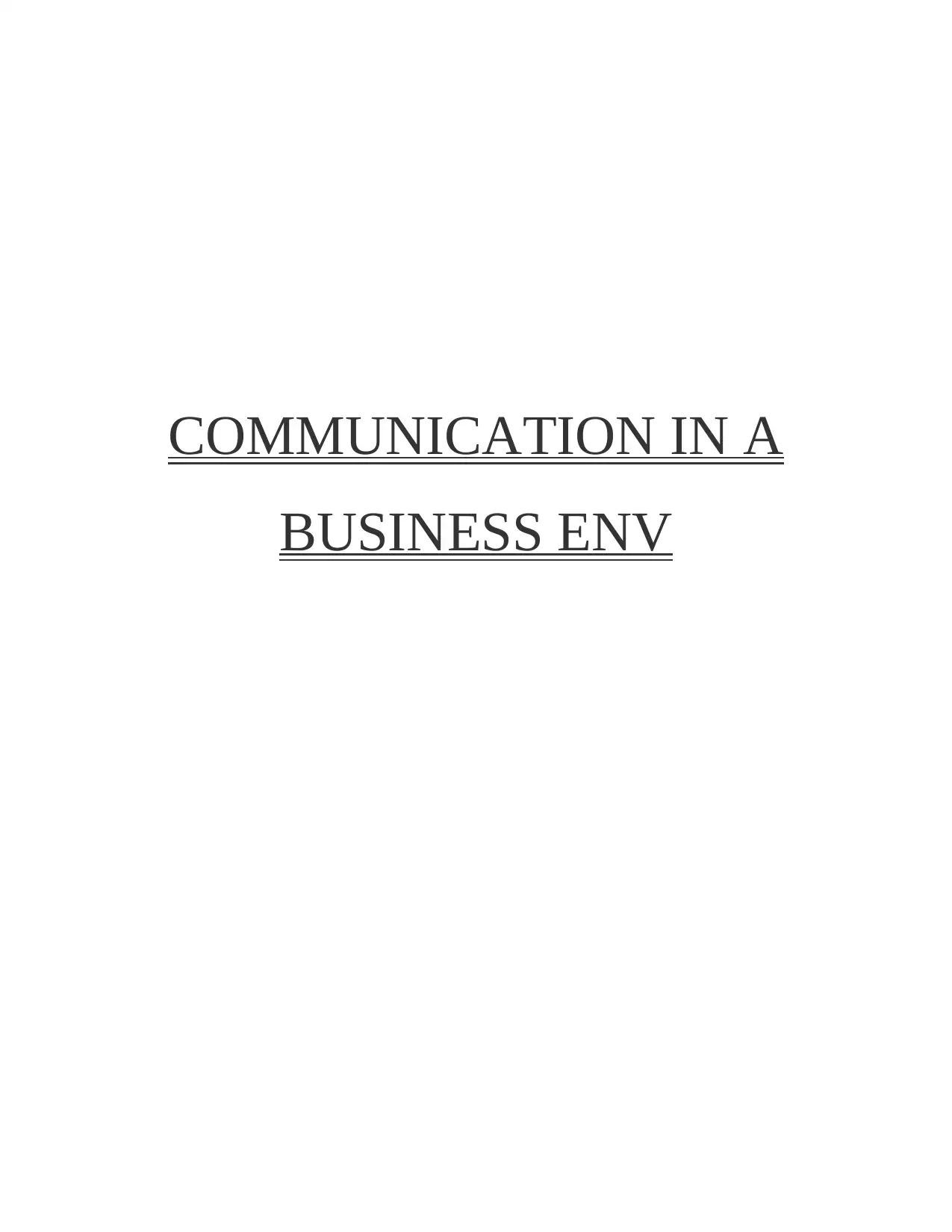
COMMUNICATION IN A
BUSINESS ENV
BUSINESS ENV
Paraphrase This Document
Need a fresh take? Get an instant paraphrase of this document with our AI Paraphraser
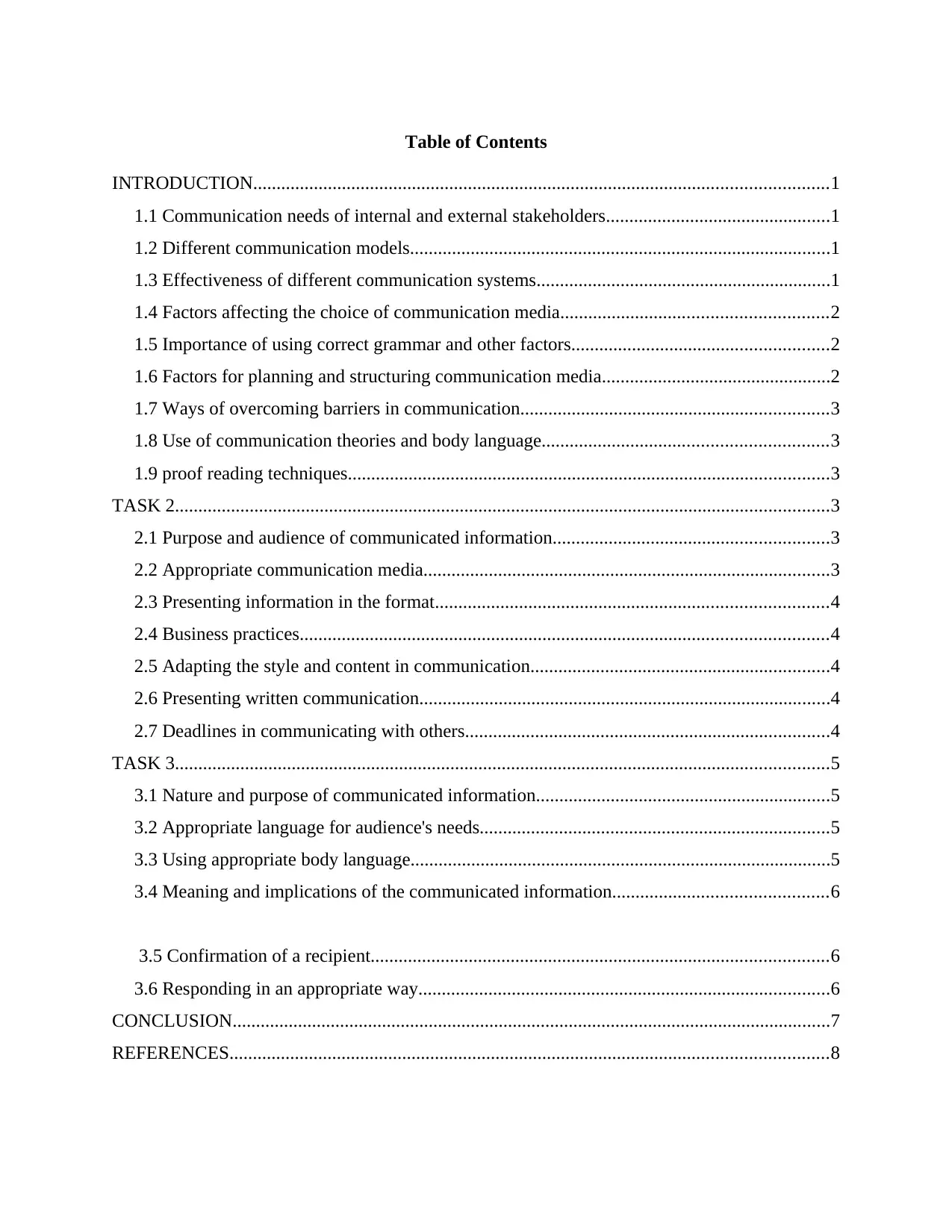
Table of Contents
INTRODUCTION...........................................................................................................................1
1.1 Communication needs of internal and external stakeholders................................................1
1.2 Different communication models..........................................................................................1
1.3 Effectiveness of different communication systems...............................................................1
1.4 Factors affecting the choice of communication media.........................................................2
1.5 Importance of using correct grammar and other factors.......................................................2
1.6 Factors for planning and structuring communication media.................................................2
1.7 Ways of overcoming barriers in communication..................................................................3
1.8 Use of communication theories and body language.............................................................3
1.9 proof reading techniques.......................................................................................................3
TASK 2............................................................................................................................................3
2.1 Purpose and audience of communicated information...........................................................3
2.2 Appropriate communication media.......................................................................................3
2.3 Presenting information in the format....................................................................................4
2.4 Business practices.................................................................................................................4
2.5 Adapting the style and content in communication................................................................4
2.6 Presenting written communication........................................................................................4
2.7 Deadlines in communicating with others..............................................................................4
TASK 3............................................................................................................................................5
3.1 Nature and purpose of communicated information...............................................................5
3.2 Appropriate language for audience's needs...........................................................................5
3.3 Using appropriate body language..........................................................................................5
3.4 Meaning and implications of the communicated information..............................................6
3.5 Confirmation of a recipient..................................................................................................6
3.6 Responding in an appropriate way........................................................................................6
CONCLUSION................................................................................................................................7
REFERENCES................................................................................................................................8
INTRODUCTION...........................................................................................................................1
1.1 Communication needs of internal and external stakeholders................................................1
1.2 Different communication models..........................................................................................1
1.3 Effectiveness of different communication systems...............................................................1
1.4 Factors affecting the choice of communication media.........................................................2
1.5 Importance of using correct grammar and other factors.......................................................2
1.6 Factors for planning and structuring communication media.................................................2
1.7 Ways of overcoming barriers in communication..................................................................3
1.8 Use of communication theories and body language.............................................................3
1.9 proof reading techniques.......................................................................................................3
TASK 2............................................................................................................................................3
2.1 Purpose and audience of communicated information...........................................................3
2.2 Appropriate communication media.......................................................................................3
2.3 Presenting information in the format....................................................................................4
2.4 Business practices.................................................................................................................4
2.5 Adapting the style and content in communication................................................................4
2.6 Presenting written communication........................................................................................4
2.7 Deadlines in communicating with others..............................................................................4
TASK 3............................................................................................................................................5
3.1 Nature and purpose of communicated information...............................................................5
3.2 Appropriate language for audience's needs...........................................................................5
3.3 Using appropriate body language..........................................................................................5
3.4 Meaning and implications of the communicated information..............................................6
3.5 Confirmation of a recipient..................................................................................................6
3.6 Responding in an appropriate way........................................................................................6
CONCLUSION................................................................................................................................7
REFERENCES................................................................................................................................8
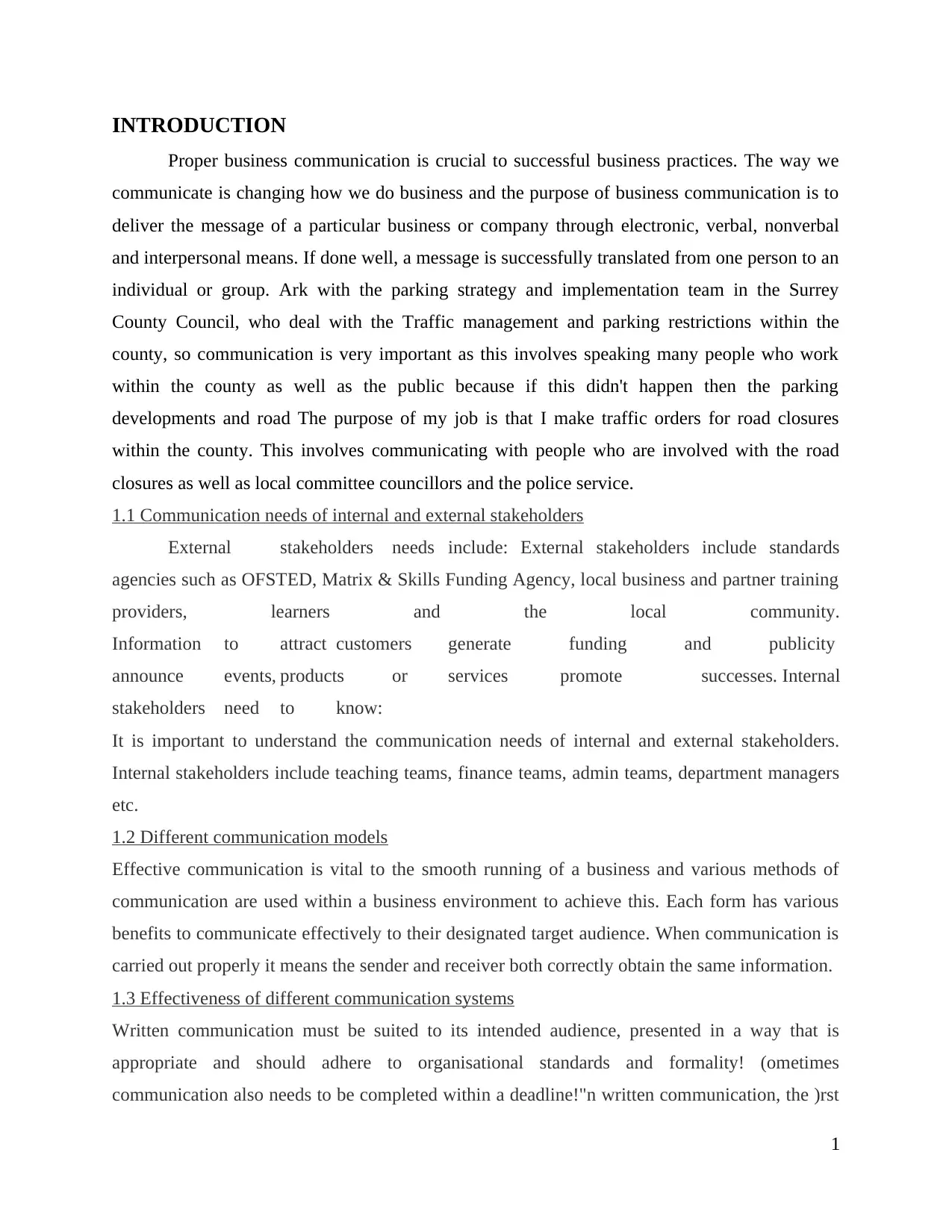
INTRODUCTION
Proper business communication is crucial to successful business practices. The way we
communicate is changing how we do business and the purpose of business communication is to
deliver the message of a particular business or company through electronic, verbal, nonverbal
and interpersonal means. If done well, a message is successfully translated from one person to an
individual or group. Ark with the parking strategy and implementation team in the Surrey
County Council, who deal with the Traffic management and parking restrictions within the
county, so communication is very important as this involves speaking many people who work
within the county as well as the public because if this didn't happen then the parking
developments and road The purpose of my job is that I make traffic orders for road closures
within the county. This involves communicating with people who are involved with the road
closures as well as local committee councillors and the police service.
1.1 Communication needs of internal and external stakeholders
External stakeholders needs include: External stakeholders include standards
agencies such as OFSTED, Matrix & Skills Funding Agency, local business and partner training
providers, learners and the local community.
Information to attract customers generate funding and publicity
announce events, products or services promote successes. Internal
stakeholders need to know:
It is important to understand the communication needs of internal and external stakeholders.
Internal stakeholders include teaching teams, finance teams, admin teams, department managers
etc.
1.2 Different communication models
Effective communication is vital to the smooth running of a business and various methods of
communication are used within a business environment to achieve this. Each form has various
benefits to communicate effectively to their designated target audience. When communication is
carried out properly it means the sender and receiver both correctly obtain the same information.
1.3 Effectiveness of different communication systems
Written communication must be suited to its intended audience, presented in a way that is
appropriate and should adhere to organisational standards and formality! (ometimes
communication also needs to be completed within a deadline!"n written communication, the )rst
1
Proper business communication is crucial to successful business practices. The way we
communicate is changing how we do business and the purpose of business communication is to
deliver the message of a particular business or company through electronic, verbal, nonverbal
and interpersonal means. If done well, a message is successfully translated from one person to an
individual or group. Ark with the parking strategy and implementation team in the Surrey
County Council, who deal with the Traffic management and parking restrictions within the
county, so communication is very important as this involves speaking many people who work
within the county as well as the public because if this didn't happen then the parking
developments and road The purpose of my job is that I make traffic orders for road closures
within the county. This involves communicating with people who are involved with the road
closures as well as local committee councillors and the police service.
1.1 Communication needs of internal and external stakeholders
External stakeholders needs include: External stakeholders include standards
agencies such as OFSTED, Matrix & Skills Funding Agency, local business and partner training
providers, learners and the local community.
Information to attract customers generate funding and publicity
announce events, products or services promote successes. Internal
stakeholders need to know:
It is important to understand the communication needs of internal and external stakeholders.
Internal stakeholders include teaching teams, finance teams, admin teams, department managers
etc.
1.2 Different communication models
Effective communication is vital to the smooth running of a business and various methods of
communication are used within a business environment to achieve this. Each form has various
benefits to communicate effectively to their designated target audience. When communication is
carried out properly it means the sender and receiver both correctly obtain the same information.
1.3 Effectiveness of different communication systems
Written communication must be suited to its intended audience, presented in a way that is
appropriate and should adhere to organisational standards and formality! (ometimes
communication also needs to be completed within a deadline!"n written communication, the )rst
1
⊘ This is a preview!⊘
Do you want full access?
Subscribe today to unlock all pages.

Trusted by 1+ million students worldwide
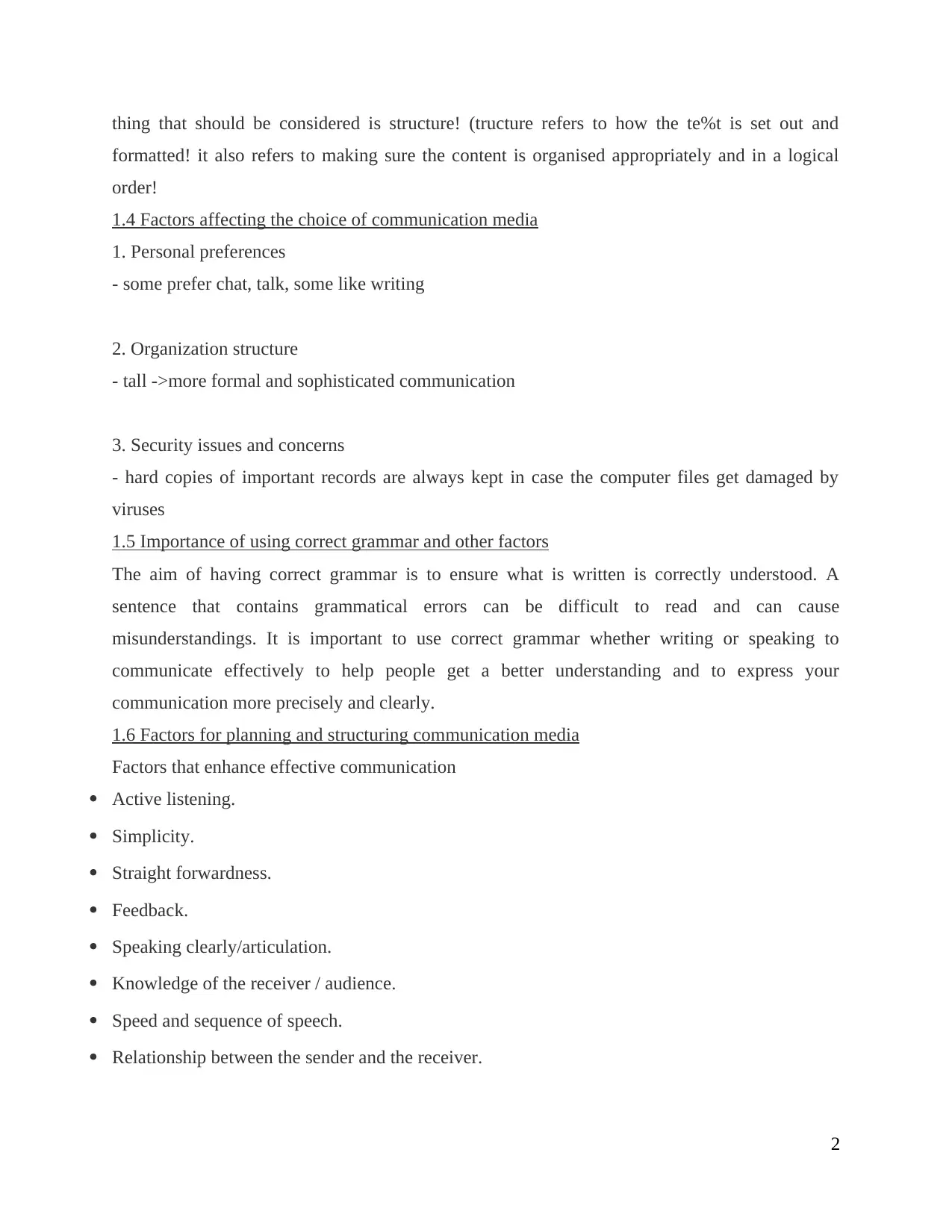
thing that should be considered is structure! (tructure refers to how the te%t is set out and
formatted! it also refers to making sure the content is organised appropriately and in a logical
order!
1.4 Factors affecting the choice of communication media
1. Personal preferences
- some prefer chat, talk, some like writing
2. Organization structure
- tall ->more formal and sophisticated communication
3. Security issues and concerns
- hard copies of important records are always kept in case the computer files get damaged by
viruses
1.5 Importance of using correct grammar and other factors
The aim of having correct grammar is to ensure what is written is correctly understood. A
sentence that contains grammatical errors can be difficult to read and can cause
misunderstandings. It is important to use correct grammar whether writing or speaking to
communicate effectively to help people get a better understanding and to express your
communication more precisely and clearly.
1.6 Factors for planning and structuring communication media
Factors that enhance effective communication
Active listening.
Simplicity.
Straight forwardness.
Feedback.
Speaking clearly/articulation.
Knowledge of the receiver / audience.
Speed and sequence of speech.
Relationship between the sender and the receiver.
2
formatted! it also refers to making sure the content is organised appropriately and in a logical
order!
1.4 Factors affecting the choice of communication media
1. Personal preferences
- some prefer chat, talk, some like writing
2. Organization structure
- tall ->more formal and sophisticated communication
3. Security issues and concerns
- hard copies of important records are always kept in case the computer files get damaged by
viruses
1.5 Importance of using correct grammar and other factors
The aim of having correct grammar is to ensure what is written is correctly understood. A
sentence that contains grammatical errors can be difficult to read and can cause
misunderstandings. It is important to use correct grammar whether writing or speaking to
communicate effectively to help people get a better understanding and to express your
communication more precisely and clearly.
1.6 Factors for planning and structuring communication media
Factors that enhance effective communication
Active listening.
Simplicity.
Straight forwardness.
Feedback.
Speaking clearly/articulation.
Knowledge of the receiver / audience.
Speed and sequence of speech.
Relationship between the sender and the receiver.
2
Paraphrase This Document
Need a fresh take? Get an instant paraphrase of this document with our AI Paraphraser
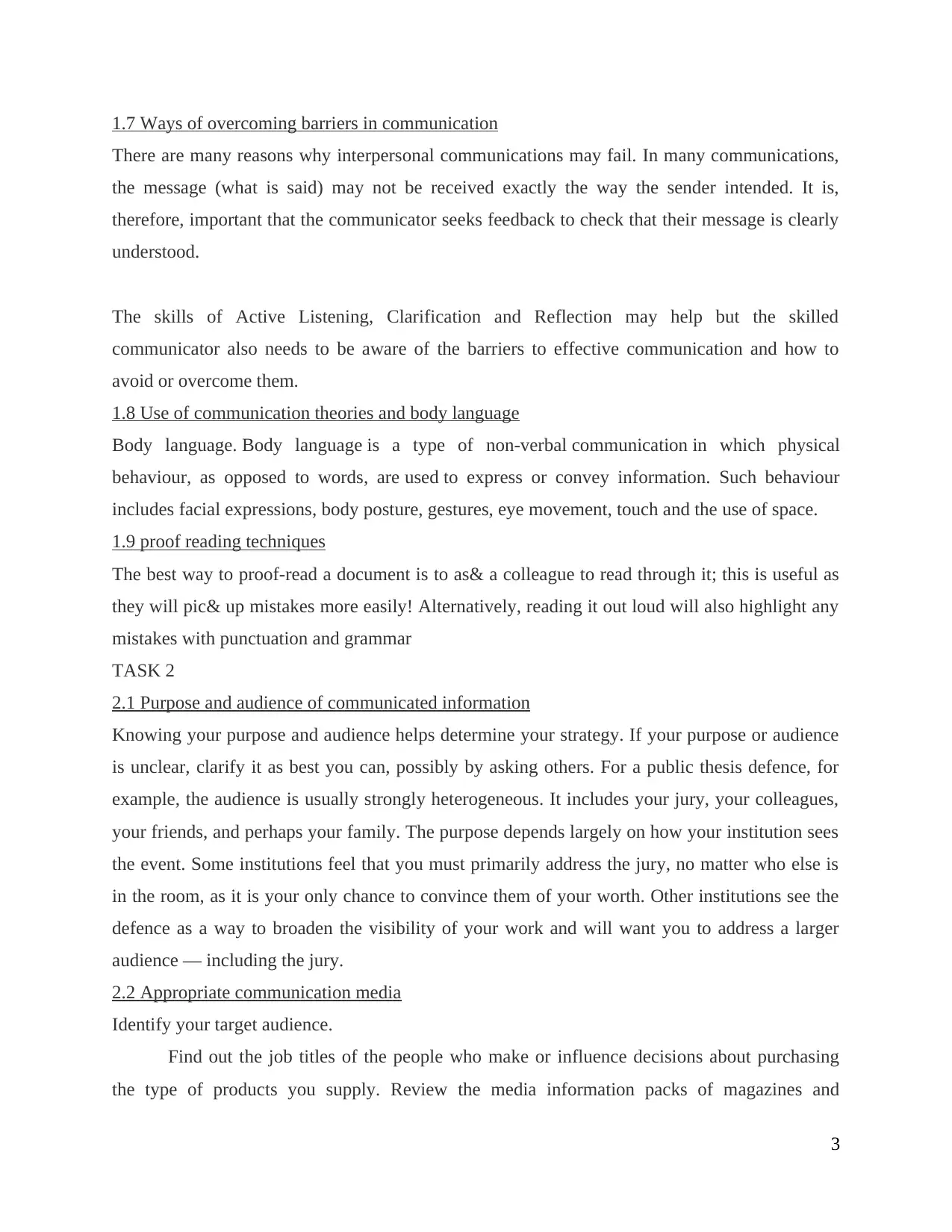
1.7 Ways of overcoming barriers in communication
There are many reasons why interpersonal communications may fail. In many communications,
the message (what is said) may not be received exactly the way the sender intended. It is,
therefore, important that the communicator seeks feedback to check that their message is clearly
understood.
The skills of Active Listening, Clarification and Reflection may help but the skilled
communicator also needs to be aware of the barriers to effective communication and how to
avoid or overcome them.
1.8 Use of communication theories and body language
Body language. Body language is a type of non-verbal communication in which physical
behaviour, as opposed to words, are used to express or convey information. Such behaviour
includes facial expressions, body posture, gestures, eye movement, touch and the use of space.
1.9 proof reading techniques
The best way to proof-read a document is to as& a colleague to read through it; this is useful as
they will pic& up mistakes more easily! Alternatively, reading it out loud will also highlight any
mistakes with punctuation and grammar
TASK 2
2.1 Purpose and audience of communicated information
Knowing your purpose and audience helps determine your strategy. If your purpose or audience
is unclear, clarify it as best you can, possibly by asking others. For a public thesis defence, for
example, the audience is usually strongly heterogeneous. It includes your jury, your colleagues,
your friends, and perhaps your family. The purpose depends largely on how your institution sees
the event. Some institutions feel that you must primarily address the jury, no matter who else is
in the room, as it is your only chance to convince them of your worth. Other institutions see the
defence as a way to broaden the visibility of your work and will want you to address a larger
audience — including the jury.
2.2 Appropriate communication media
Identify your target audience.
Find out the job titles of the people who make or influence decisions about purchasing
the type of products you supply. Review the media information packs of magazines and
3
There are many reasons why interpersonal communications may fail. In many communications,
the message (what is said) may not be received exactly the way the sender intended. It is,
therefore, important that the communicator seeks feedback to check that their message is clearly
understood.
The skills of Active Listening, Clarification and Reflection may help but the skilled
communicator also needs to be aware of the barriers to effective communication and how to
avoid or overcome them.
1.8 Use of communication theories and body language
Body language. Body language is a type of non-verbal communication in which physical
behaviour, as opposed to words, are used to express or convey information. Such behaviour
includes facial expressions, body posture, gestures, eye movement, touch and the use of space.
1.9 proof reading techniques
The best way to proof-read a document is to as& a colleague to read through it; this is useful as
they will pic& up mistakes more easily! Alternatively, reading it out loud will also highlight any
mistakes with punctuation and grammar
TASK 2
2.1 Purpose and audience of communicated information
Knowing your purpose and audience helps determine your strategy. If your purpose or audience
is unclear, clarify it as best you can, possibly by asking others. For a public thesis defence, for
example, the audience is usually strongly heterogeneous. It includes your jury, your colleagues,
your friends, and perhaps your family. The purpose depends largely on how your institution sees
the event. Some institutions feel that you must primarily address the jury, no matter who else is
in the room, as it is your only chance to convince them of your worth. Other institutions see the
defence as a way to broaden the visibility of your work and will want you to address a larger
audience — including the jury.
2.2 Appropriate communication media
Identify your target audience.
Find out the job titles of the people who make or influence decisions about purchasing
the type of products you supply. Review the media information packs of magazines and
3
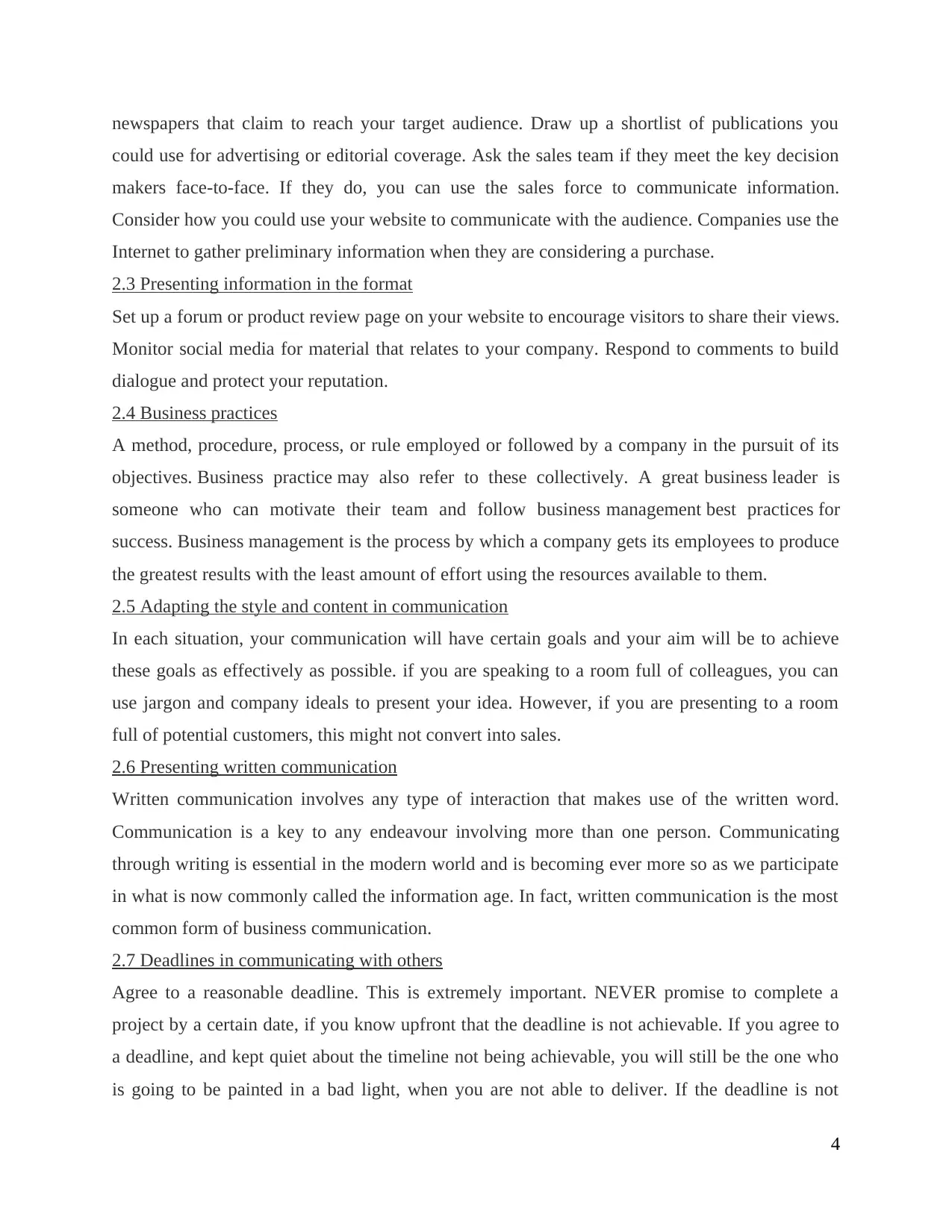
newspapers that claim to reach your target audience. Draw up a shortlist of publications you
could use for advertising or editorial coverage. Ask the sales team if they meet the key decision
makers face-to-face. If they do, you can use the sales force to communicate information.
Consider how you could use your website to communicate with the audience. Companies use the
Internet to gather preliminary information when they are considering a purchase.
2.3 Presenting information in the format
Set up a forum or product review page on your website to encourage visitors to share their views.
Monitor social media for material that relates to your company. Respond to comments to build
dialogue and protect your reputation.
2.4 Business practices
A method, procedure, process, or rule employed or followed by a company in the pursuit of its
objectives. Business practice may also refer to these collectively. A great business leader is
someone who can motivate their team and follow business management best practices for
success. Business management is the process by which a company gets its employees to produce
the greatest results with the least amount of effort using the resources available to them.
2.5 Adapting the style and content in communication
In each situation, your communication will have certain goals and your aim will be to achieve
these goals as effectively as possible. if you are speaking to a room full of colleagues, you can
use jargon and company ideals to present your idea. However, if you are presenting to a room
full of potential customers, this might not convert into sales.
2.6 Presenting written communication
Written communication involves any type of interaction that makes use of the written word.
Communication is a key to any endeavour involving more than one person. Communicating
through writing is essential in the modern world and is becoming ever more so as we participate
in what is now commonly called the information age. In fact, written communication is the most
common form of business communication.
2.7 Deadlines in communicating with others
Agree to a reasonable deadline. This is extremely important. NEVER promise to complete a
project by a certain date, if you know upfront that the deadline is not achievable. If you agree to
a deadline, and kept quiet about the timeline not being achievable, you will still be the one who
is going to be painted in a bad light, when you are not able to deliver. If the deadline is not
4
could use for advertising or editorial coverage. Ask the sales team if they meet the key decision
makers face-to-face. If they do, you can use the sales force to communicate information.
Consider how you could use your website to communicate with the audience. Companies use the
Internet to gather preliminary information when they are considering a purchase.
2.3 Presenting information in the format
Set up a forum or product review page on your website to encourage visitors to share their views.
Monitor social media for material that relates to your company. Respond to comments to build
dialogue and protect your reputation.
2.4 Business practices
A method, procedure, process, or rule employed or followed by a company in the pursuit of its
objectives. Business practice may also refer to these collectively. A great business leader is
someone who can motivate their team and follow business management best practices for
success. Business management is the process by which a company gets its employees to produce
the greatest results with the least amount of effort using the resources available to them.
2.5 Adapting the style and content in communication
In each situation, your communication will have certain goals and your aim will be to achieve
these goals as effectively as possible. if you are speaking to a room full of colleagues, you can
use jargon and company ideals to present your idea. However, if you are presenting to a room
full of potential customers, this might not convert into sales.
2.6 Presenting written communication
Written communication involves any type of interaction that makes use of the written word.
Communication is a key to any endeavour involving more than one person. Communicating
through writing is essential in the modern world and is becoming ever more so as we participate
in what is now commonly called the information age. In fact, written communication is the most
common form of business communication.
2.7 Deadlines in communicating with others
Agree to a reasonable deadline. This is extremely important. NEVER promise to complete a
project by a certain date, if you know upfront that the deadline is not achievable. If you agree to
a deadline, and kept quiet about the timeline not being achievable, you will still be the one who
is going to be painted in a bad light, when you are not able to deliver. If the deadline is not
4
⊘ This is a preview!⊘
Do you want full access?
Subscribe today to unlock all pages.

Trusted by 1+ million students worldwide
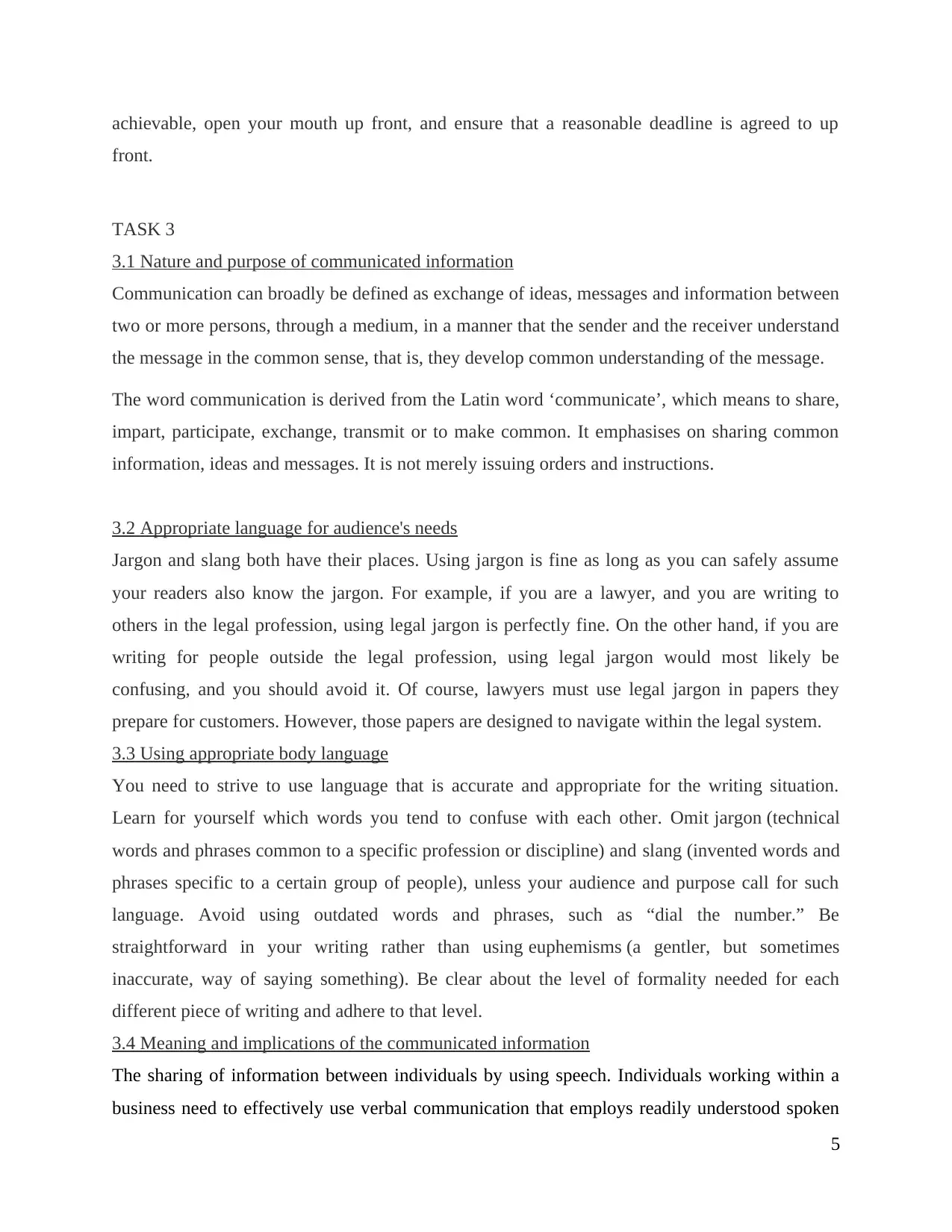
achievable, open your mouth up front, and ensure that a reasonable deadline is agreed to up
front.
TASK 3
3.1 Nature and purpose of communicated information
Communication can broadly be defined as exchange of ideas, messages and information between
two or more persons, through a medium, in a manner that the sender and the receiver understand
the message in the common sense, that is, they develop common understanding of the message.
The word communication is derived from the Latin word ‘communicate’, which means to share,
impart, participate, exchange, transmit or to make common. It emphasises on sharing common
information, ideas and messages. It is not merely issuing orders and instructions.
3.2 Appropriate language for audience's needs
Jargon and slang both have their places. Using jargon is fine as long as you can safely assume
your readers also know the jargon. For example, if you are a lawyer, and you are writing to
others in the legal profession, using legal jargon is perfectly fine. On the other hand, if you are
writing for people outside the legal profession, using legal jargon would most likely be
confusing, and you should avoid it. Of course, lawyers must use legal jargon in papers they
prepare for customers. However, those papers are designed to navigate within the legal system.
3.3 Using appropriate body language
You need to strive to use language that is accurate and appropriate for the writing situation.
Learn for yourself which words you tend to confuse with each other. Omit jargon (technical
words and phrases common to a specific profession or discipline) and slang (invented words and
phrases specific to a certain group of people), unless your audience and purpose call for such
language. Avoid using outdated words and phrases, such as “dial the number.” Be
straightforward in your writing rather than using euphemisms (a gentler, but sometimes
inaccurate, way of saying something). Be clear about the level of formality needed for each
different piece of writing and adhere to that level.
3.4 Meaning and implications of the communicated information
The sharing of information between individuals by using speech. Individuals working within a
business need to effectively use verbal communication that employs readily understood spoken
5
front.
TASK 3
3.1 Nature and purpose of communicated information
Communication can broadly be defined as exchange of ideas, messages and information between
two or more persons, through a medium, in a manner that the sender and the receiver understand
the message in the common sense, that is, they develop common understanding of the message.
The word communication is derived from the Latin word ‘communicate’, which means to share,
impart, participate, exchange, transmit or to make common. It emphasises on sharing common
information, ideas and messages. It is not merely issuing orders and instructions.
3.2 Appropriate language for audience's needs
Jargon and slang both have their places. Using jargon is fine as long as you can safely assume
your readers also know the jargon. For example, if you are a lawyer, and you are writing to
others in the legal profession, using legal jargon is perfectly fine. On the other hand, if you are
writing for people outside the legal profession, using legal jargon would most likely be
confusing, and you should avoid it. Of course, lawyers must use legal jargon in papers they
prepare for customers. However, those papers are designed to navigate within the legal system.
3.3 Using appropriate body language
You need to strive to use language that is accurate and appropriate for the writing situation.
Learn for yourself which words you tend to confuse with each other. Omit jargon (technical
words and phrases common to a specific profession or discipline) and slang (invented words and
phrases specific to a certain group of people), unless your audience and purpose call for such
language. Avoid using outdated words and phrases, such as “dial the number.” Be
straightforward in your writing rather than using euphemisms (a gentler, but sometimes
inaccurate, way of saying something). Be clear about the level of formality needed for each
different piece of writing and adhere to that level.
3.4 Meaning and implications of the communicated information
The sharing of information between individuals by using speech. Individuals working within a
business need to effectively use verbal communication that employs readily understood spoken
5
Paraphrase This Document
Need a fresh take? Get an instant paraphrase of this document with our AI Paraphraser
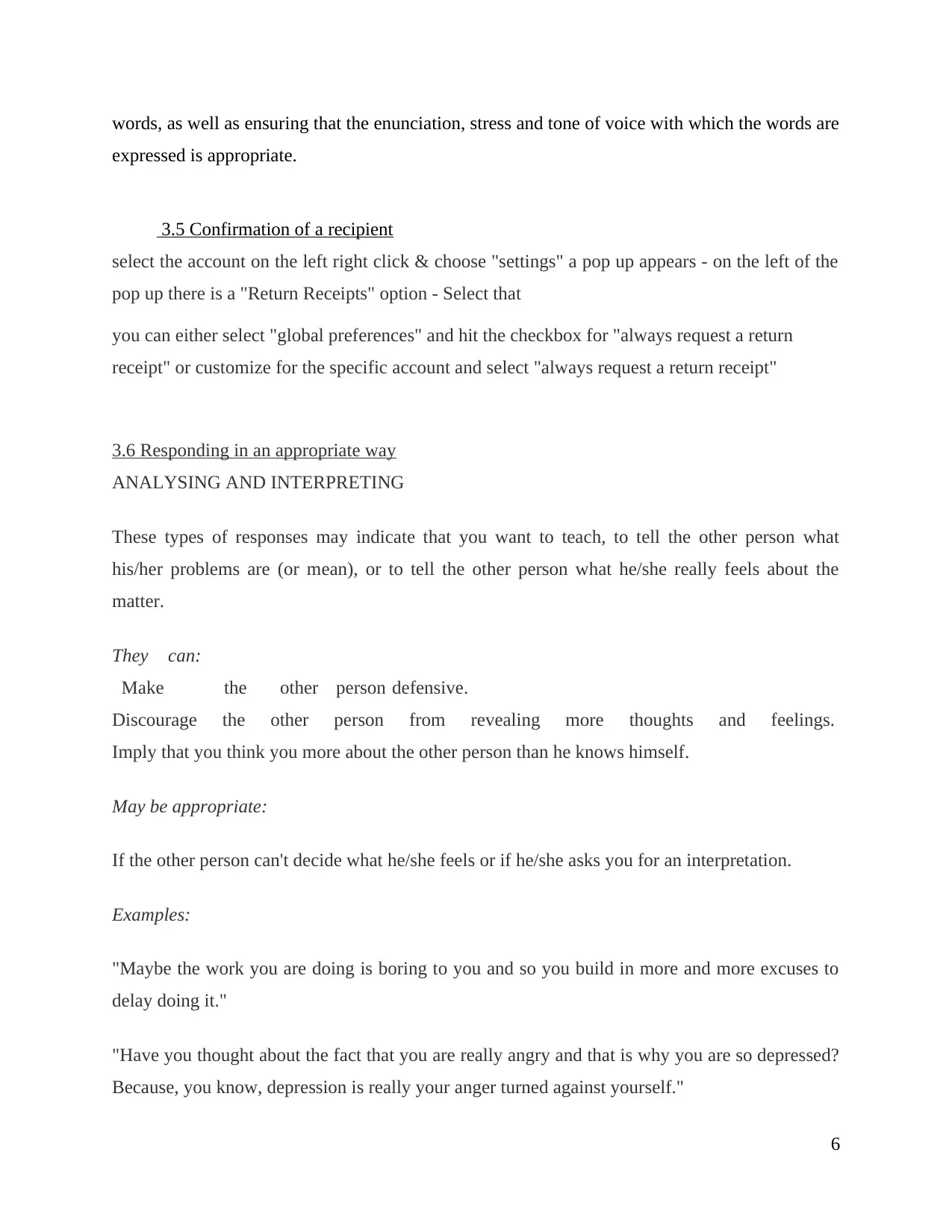
words, as well as ensuring that the enunciation, stress and tone of voice with which the words are
expressed is appropriate.
3.5 Confirmation of a recipient
select the account on the left right click & choose "settings" a pop up appears - on the left of the
pop up there is a "Return Receipts" option - Select that
you can either select "global preferences" and hit the checkbox for "always request a return
receipt" or customize for the specific account and select "always request a return receipt"
3.6 Responding in an appropriate way
ANALYSING AND INTERPRETING
These types of responses may indicate that you want to teach, to tell the other person what
his/her problems are (or mean), or to tell the other person what he/she really feels about the
matter.
They can:
Make the other person defensive.
Discourage the other person from revealing more thoughts and feelings.
Imply that you think you more about the other person than he knows himself.
May be appropriate:
If the other person can't decide what he/she feels or if he/she asks you for an interpretation.
Examples:
"Maybe the work you are doing is boring to you and so you build in more and more excuses to
delay doing it."
"Have you thought about the fact that you are really angry and that is why you are so depressed?
Because, you know, depression is really your anger turned against yourself."
6
expressed is appropriate.
3.5 Confirmation of a recipient
select the account on the left right click & choose "settings" a pop up appears - on the left of the
pop up there is a "Return Receipts" option - Select that
you can either select "global preferences" and hit the checkbox for "always request a return
receipt" or customize for the specific account and select "always request a return receipt"
3.6 Responding in an appropriate way
ANALYSING AND INTERPRETING
These types of responses may indicate that you want to teach, to tell the other person what
his/her problems are (or mean), or to tell the other person what he/she really feels about the
matter.
They can:
Make the other person defensive.
Discourage the other person from revealing more thoughts and feelings.
Imply that you think you more about the other person than he knows himself.
May be appropriate:
If the other person can't decide what he/she feels or if he/she asks you for an interpretation.
Examples:
"Maybe the work you are doing is boring to you and so you build in more and more excuses to
delay doing it."
"Have you thought about the fact that you are really angry and that is why you are so depressed?
Because, you know, depression is really your anger turned against yourself."
6
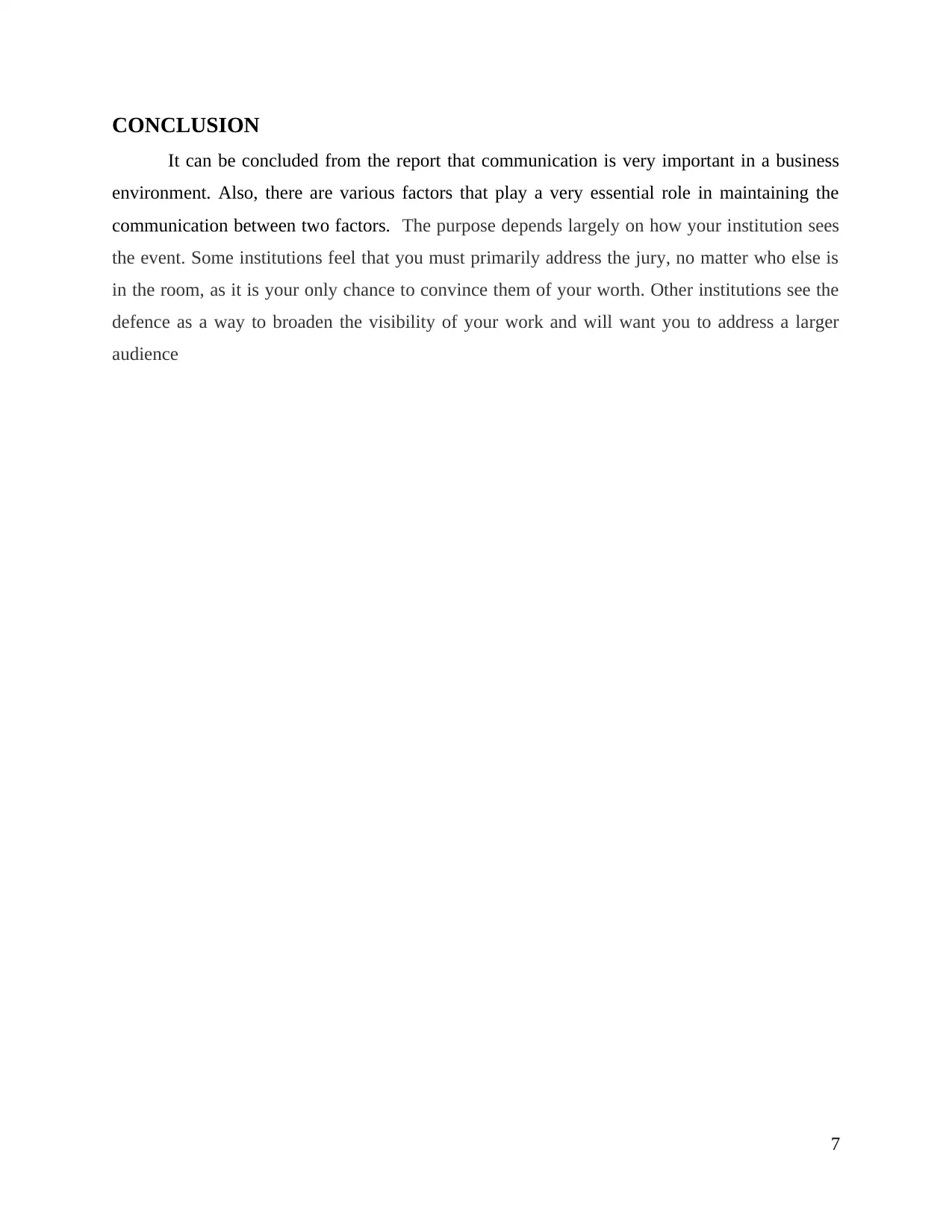
CONCLUSION
It can be concluded from the report that communication is very important in a business
environment. Also, there are various factors that play a very essential role in maintaining the
communication between two factors. The purpose depends largely on how your institution sees
the event. Some institutions feel that you must primarily address the jury, no matter who else is
in the room, as it is your only chance to convince them of your worth. Other institutions see the
defence as a way to broaden the visibility of your work and will want you to address a larger
audience
7
It can be concluded from the report that communication is very important in a business
environment. Also, there are various factors that play a very essential role in maintaining the
communication between two factors. The purpose depends largely on how your institution sees
the event. Some institutions feel that you must primarily address the jury, no matter who else is
in the room, as it is your only chance to convince them of your worth. Other institutions see the
defence as a way to broaden the visibility of your work and will want you to address a larger
audience
7
⊘ This is a preview!⊘
Do you want full access?
Subscribe today to unlock all pages.

Trusted by 1+ million students worldwide
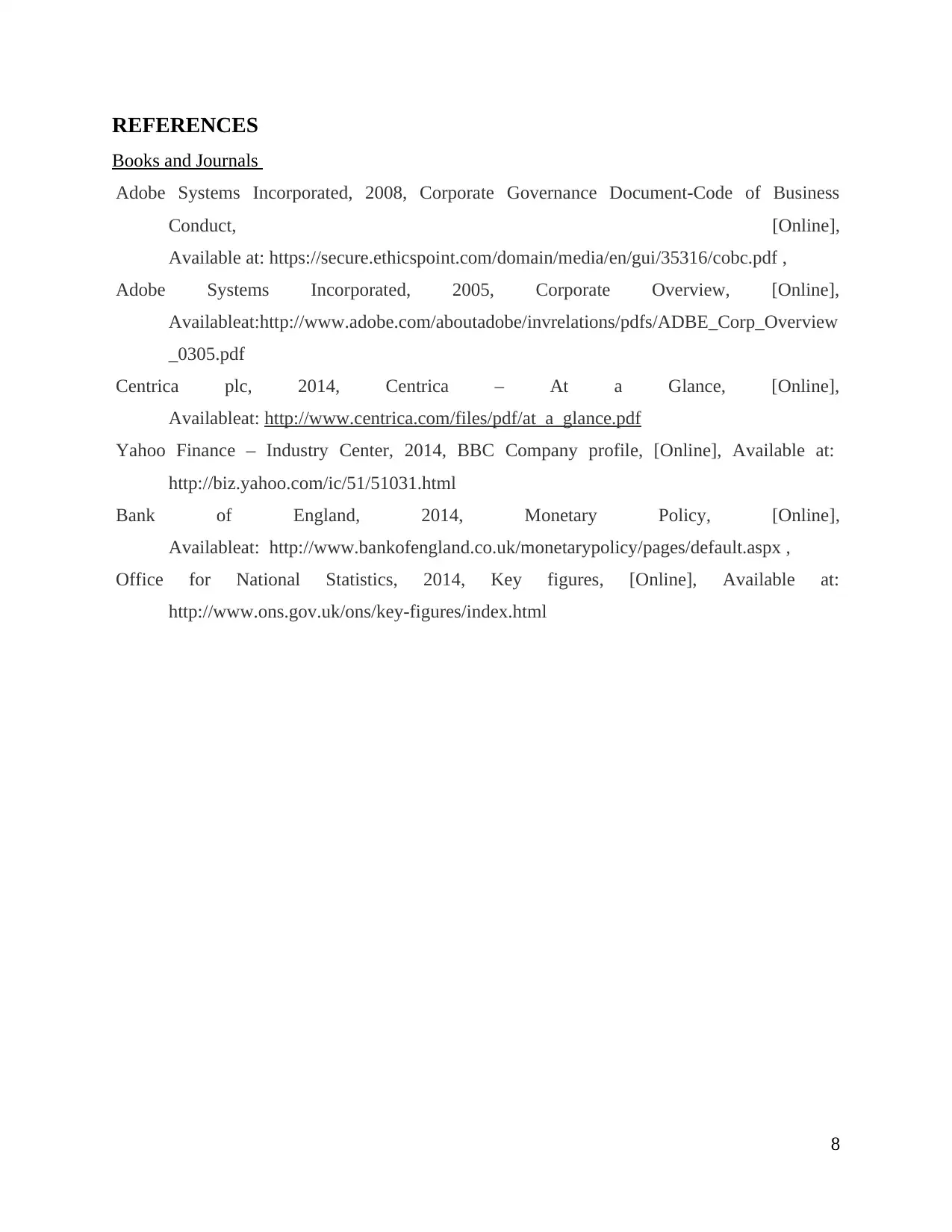
REFERENCES
Books and Journals
Adobe Systems Incorporated, 2008, Corporate Governance Document-Code of Business
Conduct, [Online],
Available at: https://secure.ethicspoint.com/domain/media/en/gui/35316/cobc.pdf ,
Adobe Systems Incorporated, 2005, Corporate Overview, [Online],
Availableat:http://www.adobe.com/aboutadobe/invrelations/pdfs/ADBE_Corp_Overview
_0305.pdf
Centrica plc, 2014, Centrica – At a Glance, [Online],
Availableat: http://www.centrica.com/files/pdf/at_a_glance.pdf
Yahoo Finance – Industry Center, 2014, BBC Company profile, [Online], Available at:
http://biz.yahoo.com/ic/51/51031.html
Bank of England, 2014, Monetary Policy, [Online],
Availableat: http://www.bankofengland.co.uk/monetarypolicy/pages/default.aspx ,
Office for National Statistics, 2014, Key figures, [Online], Available at:
http://www.ons.gov.uk/ons/key-figures/index.html
8
Books and Journals
Adobe Systems Incorporated, 2008, Corporate Governance Document-Code of Business
Conduct, [Online],
Available at: https://secure.ethicspoint.com/domain/media/en/gui/35316/cobc.pdf ,
Adobe Systems Incorporated, 2005, Corporate Overview, [Online],
Availableat:http://www.adobe.com/aboutadobe/invrelations/pdfs/ADBE_Corp_Overview
_0305.pdf
Centrica plc, 2014, Centrica – At a Glance, [Online],
Availableat: http://www.centrica.com/files/pdf/at_a_glance.pdf
Yahoo Finance – Industry Center, 2014, BBC Company profile, [Online], Available at:
http://biz.yahoo.com/ic/51/51031.html
Bank of England, 2014, Monetary Policy, [Online],
Availableat: http://www.bankofengland.co.uk/monetarypolicy/pages/default.aspx ,
Office for National Statistics, 2014, Key figures, [Online], Available at:
http://www.ons.gov.uk/ons/key-figures/index.html
8
1 out of 10
Related Documents
Your All-in-One AI-Powered Toolkit for Academic Success.
+13062052269
info@desklib.com
Available 24*7 on WhatsApp / Email
![[object Object]](/_next/static/media/star-bottom.7253800d.svg)
Unlock your academic potential
Copyright © 2020–2025 A2Z Services. All Rights Reserved. Developed and managed by ZUCOL.





